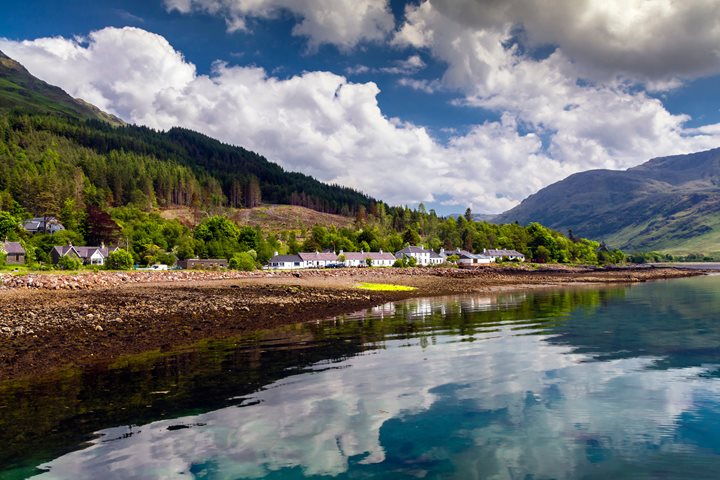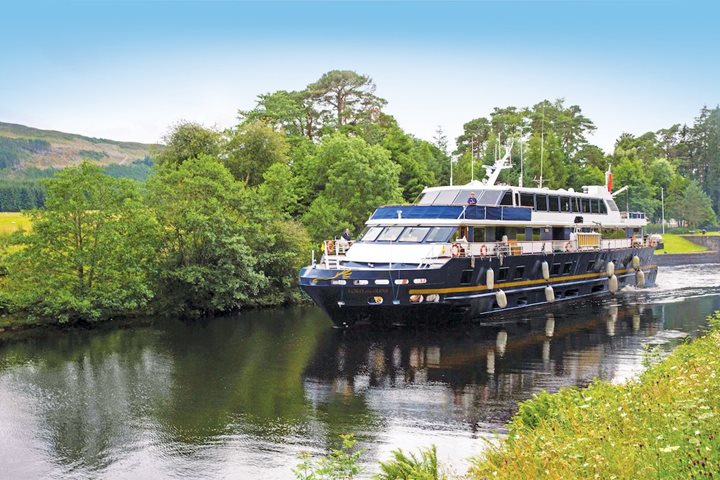Call +1.800.397.3348 or contact your travel advisor
With rolling hills dotted with sheep, misty peaks, lush green dells as far as the eye can see, and rivers coursing between sweeping valleys, it’s easy to see why the directors of Harry Potter, Game of Thrones, and Braveheart set their films in the Scottish Highlands. The 62-mile Great Glen seems to have been created by uncorking bucolic landscapes and spilling them over the Atlantic and North Sea in a colossal rush of isles, lochs, and canals. Get Inspired By Photos, Videos, Webinars, Stories, And Exclusive Offers. Sign Up
Winding through the heart of Scotland, the Caledonian Canal was completed in 1822 after 19 years of construction. Designed to connect the country's east and west coasts and save ships time in sailing around Scotland, the 60-mile canal traverses three lochs and 29 locks. Transits along Loch Ness, Loch Oich, and Loch Lochy constitute 38 miles of the journey. To address the different water levels along the route, locks were engineered. The most famous of these is Neptune’s Staircase, a series of eight locks that raise the canal by more than 62 feet. Vessels travel slowly through the dramatic rising and falling of water levels, which takes approximately 90 minutes. All aboard are treated to an uninterrupted view of the machinations of the 22-ton gates, as well as vistas of the picturesque village of Banavie and just beyond, Ben Nevis, Great Britain’s highest peak.
Once built as a safer wartime route for the British Royal Navy as well as for bustling passenger ships, the Caledonian Canal now accommodates only smaller vessels since many more modernly built ships have outgrown it.
The largest vessel to traverse the locks, Lord of the Glens transits the canal in summer. Forty-eight guests board this stately ship purpose-built for navigating stepped locks and narrow canals, gliding along tree-lined shores and disembarking in locations such as the historic battlefield of Culloden and the mountain village of Glenfinnan. An iconic Scottish sight explorers on board might chance upon is the Jacobite steam train of Hogwarts Express fame chugging through the heart of Fort Augustus and Fort William and across the Glenfinnan Viaduct. The garnet-colored train presents an incredible photo op as it cuts a path through the vale with rugged mountains for a backdrop and billows of steam swallowed by low-hanging clouds.
There are opportunities for guests to walk or bike on the canal’s towpath or the Great Glen Way, a 77-mile path that runs alongside the canal. Others will be happy to simply, as the Scots might say, gongoozle—watch boat activity on the canals. Lord of the Glens continues down the glen’s natural faultlines, sailing in the crook of Loch Linne and emerging into the Inner Hebrides. It is the only ship of its kind able to navigate both the locks of the Caledonian Canal and the beautiful isles of the Inner Hebrides. Bridging together both water- and land-based exploration, as well as serene inland landscapes and wild, windswept islands, an expedition to the Scottish Highlands aboard Lord of the Glens promises a journey like no other.
To experience all of the above, plus much more, join us aboard Lord of the Glens on Scotland's Highlands & Islands.




